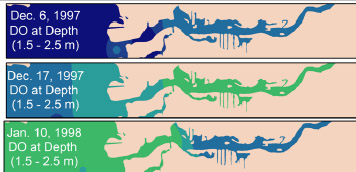High Time Resolution Monitoring of Inorganic Nitrogen Fluxes into Hillsborough- Tampa Bay from the Alafia River, Florida
Main Article Content
Abstract
Limiting the nutrient loading to the Tampa Bay estuary may improve the growth of seagrasses and the overall quality of the Tampa Bay watershed. As a preliminary step to understanding nutrient loading and recycling within Tampa Bay, we investigated the fluxes of
Inorganic Nitrogenous Nutrient (INN) species (ammonium, nitrite, and nitrate) from the Alafia River into the Hillsborough Bay, a segment of the greater Tampa Bay estuary. Sampling was focused on periods of high precipitation during an El Nino period, a period when an unusually
high precipitation occurred. High concentrations of ammonium were initially seen in surface waters, indicating probable runoff from the nearby Cargill fertilizer plant. With the normal monthly or bi-monthly sampling by this group or the Hillsborough Environmental Protection
Commission (HEPC), we found that it was not possible to accurately determine inorganic nitrogen loads, point and non-point sources, or nutrient cycling as a result of the transient character of the inorganic nitrogen fluxes. However, with a High Time Re solution Monitoring
(HTRM) program developed by this group, it was possible to identify a region characterized by either vigorous nutrient cycling in which high levels of ammonium were generated locally or as a result of ammonium-rich groundwater discharge, particularly in the more saline bottom waters of the deeper parts of the estuary.
Article Details
Published articles are under the copyright of the Environment and Natural Resources Journal effective when the article is accepted for publication thus granting Environment and Natural Resources Journal all rights for the work so that both parties may be protected from the consequences of unauthorized use. Partially or totally publication of an article elsewhere is possible only after the consent from the editors.

